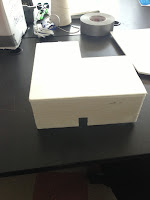Design Methods:
- Assume a beginner's mindset: set aside any biases to begin a task with fresh ideas.
Don’t judge - I thought Mr. Hoang would focus more on the exterior when in reality he wanted more detail inside of the house.
question everything - We made sure Mr. Hoang really wanted to focus on certain things in his house by asking questions
find patterns - we noticed he wanted a more themed house, with basketball players and games in every room
- What? How? Why?: allows you to move from concrete observations of the happenings of a
particular situation to the more abstract potential emotions and motives that are at play in the situation you’re observing
Set-up: we used a paper to figure out the design and ideas(what). Also by designing we figured out how to build objects(how). By asking Mr. Hoang questions we figured out why and jotted those down on paper(why).
Move to understanding: Mr. Hoang wanted an outrageous house on the inside because that’s how he wants his students to see him
- Prepare for an interview: the only way to have an efficient interview is by preparing for it
Brainstorm questions: On our way to talk to Mr. Hoang we came up with questions to help Mr. Hoang come up with ideas
Refine Questions: We established detailed questions so the answers doesn’t lead to more questions
- Interview for empathy: helps to understand the client and why they decide on some things
Encourage stories: Mr. Hoang made up stories about what would happen in his house and so we understand more why Mr. Hoang wanted those specific things.
Ask answers neutrally: We made sure to never ask Mr. hoang questions and then say “Well I think I would do something like...”
- Saturate and group: come up with many ideas and then organize them into groups
Discuss: John, Sam and I discussed ideas before we wrote them down or talked to Mr.
Hoang just in case he did need help deciding a design
Write down all ideas: Even some ideas were not the best we still wrote them down just to establish ideas and they could possibly lead to other ideas
- Composite Character Profile: focus the team's attention on the salient and relevant characteristics of the user whom they wish to address
Unpack observations: We observed our client, Mr. Hoang, as we interviewed him to get to know him a little better
Unpack ideas: After our observations we were able to come up with certain ideas
- Powers of ten: use an intentional approach to considering the problem at varied magnitudes of framing
- 2x2 Matrix: relationship between things and people
- Why-How Laddering: flesh out a number of needs, and find a middle stratum of needs that are both meaningful and actionable
Needs of user: We had to think of the things Mr. Hoang would find most meaningful, like his master bedroom and his work space vs. his wife’s
Ask why?: We had to ask Mr. Hoang why he actually needed some things in his house and it helped simplify the house because he would decide things were too difficult
- POV Madlib: captures your design vision – your responsibility and opportunity as a designer is to discover and articulate the meaningful challenge
- POV Analogy: yield a strong directive of how you go about designing the final solution.
- Critical reading checklist: ensure that your team's POV is valid, insightful, actionable, unique, narrow, meaningful, and exciting
What’s the point?: This helped us with our POV and understanding
Who cares?: Mr. Hoang cared, therefore we had to really care about what we were doing
-Design Principles:give you a format to capture abstracted, but actionable, guidelines for
solutions, and communicate your design intentions to others.
- “How might we” questions: short questions that launch brainstorms
- Brainstorming: come up with design solutions









